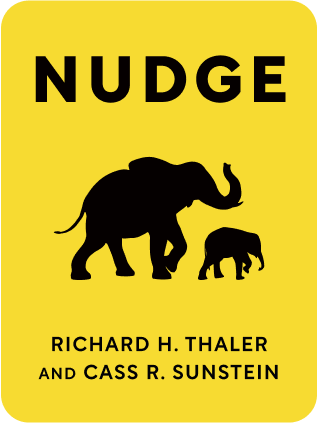

This article is an excerpt from the Shortform summary of "Nudge" by Richard H. Thaler and Cass R. Sunstein. Shortform has the world's best summaries of books you should be reading.
Like this article? Sign up for a free trial here .
What is a choice architect? How does a choice architect help implement nudges?
A choice architect is a person that designs the options available in a given situation. The choice architects may also set the default choice.
Read on to understand what a choice architect is and see some choice architecture examples.
The Need for a Choice Architect
One of the most effective ways to nudge a chooser is the educated and purposeful design of the choice system.
No matter what choices are being offered, choice architects must honor the psychological principle of stimulus-response capability—that is, the principle that a particular stimulus must correspond to the desired action. For example, if a door only opens in one direction, don’t put handles on both sides: Put the handles on the side that pulls open, and a flat plate on the side that should be pushed. Similarly, if you want people to make good choices, don’t present each choice uniformly or randomly.
Choice Architecture Examples of Defaults
Due to human predilections like the status quo bias (see Chapter 1), choosers will often opt for the choice that takes the least effort: the default that requires the chooser to do nothing. And so a choice architect can drastically affect outcomes by designing their default options conscientiously.
For example, say you’re currently enrolled in a particular health insurance option through your employer and you completely space on the next year’s open enrollment period. Should your employer assume you don’t want health coverage for the following year, or should it re-enroll you in the same option you had the previous year? Most of us would choose the latter, which means that’s the better default.
(Sometimes, in complex or fraught circumstances, the choice architects should omit defaults. For example, if federal law mandates that schools supply student information to military recruiters but allows for opt outs, the school might default to neither option and ask parents or students to make the choice themselves.)
A Choice Architect Anticipates Error
A sophisticated choice architect not only knows choosers make mistakes but also knows what kind of mistakes choosers make.
Take, for example, a drug manufacturer developing a new medication. Should that medication be designed to be taken once a day, once every other day, twice a day, or three times a week? The best option is once a day, because the more regularly a person has to take a dose, the fewer opportunities that person has to forget to take a dose.
Transmit Feedback
Humans can learn from their mistakes, but all too often, choice systems neglect to provide feedback to choosers. A well-designed choice system gives choosers instant feedback on the choices they’ve made.
Consider an online interface for a health insurance marketplace. When you select a particular health insurance plan and proceed to finalize your choice, the system might ask a question or two about your health needs or finances before allowing you to make the election. If your answers indicate that your particular election might not be the best plan for you, the system might alert you to the mismatch.
Draw Choosers a Map
Often, especially when it comes to hard decisions in specialized fields like medicine, choosers have difficulty “mapping” their choices onto their eventual benefits. Choice architects can aid choosers by explaining the benefits and outcomes of choices in familiar terms, so that mapping becomes easy.
Take credit cards for example. The typical credit card comes with an array of features and costs: cash-back rewards and annual fees, frequent-flyer miles and variable interest rates, discounts and late-payment charges. The average consumer isn’t able to map his or her choice of credit card onto his or her welfare—the pluses and minuses of each credit card are just too complex to make sense of.
With the help of some mild government regulation, however, credit cards can become much easier to map. The solution is the RECAP system: Record, Evaluate, and Compare Alternative Prices.
Under RECAP, credit card companies would be required to (1) release a clearly organized document with formulas for their entire fee schedule (the formulas would show consumers what happens if they make purchases in a foreign currency, for example, or miss a payment) and (2) send cardholders an annual report describing precisely how they used their card and what fees were incurred. The consumer could then take that information to a private website that compares credit cards, plug in his or her usage data, and see what competing cards would have charged for the same usage.
A Choice Architect Structures Large Choice Sets
Choice architects’ job is easy when there are few options to choose from—humans can relatively easily distinguish between three or four options, weigh the benefits and tradeoffs of each, and make a well-grounded decision. When there are many options, however—dozens, say—it’s incumbent on the choice architects to structure those choices to minimize confusion and error.
A company like Amazon has mastered the art of structuring choice. For example, rather than presenting customers with random bundles of goods, Amazon uses browsing and order history to filter options and make recommendations.
(Of course, “collaborative filtering” techniques like these limit our chances to discover something completely new, because they constantly offer us choices based on our personal tastes or prior behavior. A choice architect, like a newspaper publisher, nudges us toward new and important information regardless of our personal tastes.)
Incentivize With Choice Architecture
Although the price function—whether something is expensive or cheap—gives a chooser enough information to make a sound decision most of the time, sometimes Humans (rather than Econs) don’t notice the relevant economic incentive. This is where creative choice architecture examples can be a boon—by making the economic incentives of a given choice more “salient” (or obvious).
For example, when we crank A/C on a hot day, we may have an inkling that we’re incurring a cost, but we don’t truly recognize it until we receive our electricity bill at the end of the month. If our thermostat displayed the cost per hour of the new colder temperature—thereby making the cost of our choice more “salient”—we might be more inclined to think twice about lowering the thermostat.

———End of Preview———
Like what you just read? Read the rest of the world's best summary of Richard H. Thaler and Cass R. Sunstein's "Nudge" at Shortform .
Here's what you'll find in our full Nudge summary :
- Why subtle changes, like switching the order of two choices, can dramatically change your response
- How to increase the organ donation rate by over 50% through one simple change
- The best way for society to balance individual freedom with social welfare






